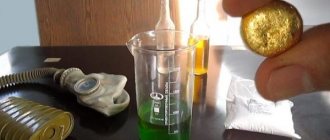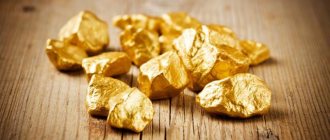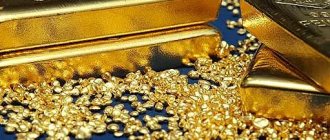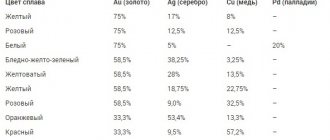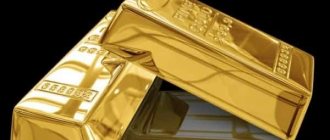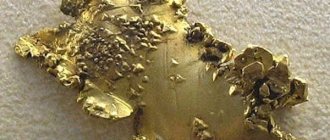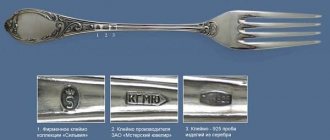Refineries in Russia
May 14, 2012
In Russia, the geography of gold supplies to refineries is subjective and changes quite often. When choosing a refinery, the decisive role is played not so much by its location as by the cost of refining, which is not stable and the same for similar industries.
The following have the right to refining precious metals - it was built in 1974 in the city of Kasimov, Ryazan region. Initially the plant produced iron. However, in 1991, by government decision, the plant was repurposed for gold processing. The plant produced gold of the highest standard (99.99) to replenish Russia's gold reserves. The creation of a refining giant in the Ryazan region was “justified” only by its proximity to the main consumer of gold - Gokhran. In modern conditions, it has become unprofitable to use this enterprise for refining gold in the North-East, Primorye and Eastern Siberia. In the context of the abandonment of the state monopoly on the purchase of gold, the establishment of free prices for precious metals, taking into account the transport costs of transporting semi-finished gold products from suppliers, the Prioksky Non-Ferrous Metals Plant lost its status as a monopolist in the production of gold for the Russian gold reserve.
2) “Novosibirsk Refinery” - the famous and oldest in Russia - until the beginning of the 90s, it processed about 60% of the mined gold and handed it over to Gokhran. The technology of dissolution in aqua regia and high production standards made it possible to produce gold of excellent quality. After the creation of the Prioksky giant, the Novosibirsk Refinery managed not only to maintain its production and continue to function, but also to become the main competitor of the Prioksky Non-Ferrous Metals Plant.
3) “Krasnoyarsk Non-Ferrous Metals Plant” (OJSC “Krastsvetmet”) was built in 1939-1943 for the production of refined platinum metals from sulfide copper-nickel ores of the Norilsk deposit. Currently, the plant is listed as the only Russian producer of all types of precious metals (platinum group metals, gold, silver). In the structure of raw material supplies, 70% are concentrates from the Norilsk plant. OJSC "Krastsvetmet" is included in the lists of producers of precious metals according to the "Good Delivery" standard on the London, Tokyo and New York exchanges.
4) “Shchelkovsky Plant of Secondary Precious Metals” - located in the Moscow region and specializes in processing secondary precious metals. It accepts for processing metals containing more than 2% gold and more than 5% silver, i.e. relatively rich raw materials, the quantity of which is limited.
5) “Kolyma Refinery” was put into operation in 1998 in the Magadan region. The Kolyma plant owes its location to the decision of the regional authorities to create its own refining production, focused on local raw materials.
6) “Ekaterinburg Non-Ferrous Metals Processing Plant” (EzOTsM) is the oldest enterprise in Russia. It was created in 1916 for the refining of platinum group metals. In addition, today the plant refines spot gold, processes alloys, and also extracts precious metals from secondary raw materials. Unlike other refineries in Russia, EzOTsM produces both a wide range of technical products from pure precious metals, as well as their alloys, and jewelry from the main precious metals: gold, silver, platinum and palladium. The plant has a “Good Delivery” certificate for gold, silver, platinum and palladium. 7) JSC Uralelectromed is located in the city of Verkhnyaya Pyshma, Sverdlovsk region. Previously, the plant was one of the main suppliers of gold to the state, accumulating precious metals in a silver-gold alloy. The raw material basis for gold production at Uralelectromed JSC is copper concentrates - the so-called “copper gold”. The share of secondary raw materials based on copper or its alloys is also significant.
 "Kyshtym Copper Electrolyte Plant" is located in the city of Kyshtym, Chelyabinsk region. Extracts precious metals from low-grade scrap containing gold and silver without platinum group metals.
"Kyshtym Copper Electrolyte Plant" is located in the city of Kyshtym, Chelyabinsk region. Extracts precious metals from low-grade scrap containing gold and silver without platinum group metals.
gold, silver, Russia, business
4
leave a comment
London Metal Exchange
The London Metal Exchange is the world's largest platform for transactions with non-ferrous metals plus rolled aluminum. The exchange also provides quotes for rare and precious metals...
History of Sberbank
Sberbank of Russia is the largest financial institution in Russia. In 2011, the bank celebrates the 170th anniversary of its existence. Throughout history, the bank has managed to maintain its stable operation...
Napoleon's counterfeit money
In the wars of the 18th and 19th centuries. issuing counterfeit enemy money was a common practice to undermine the enemy's economy. Before the invasion, Napoleon produced counterfeit banknotes of various denominations...
Monopolization of the gold market in Vietnam by the state
The Vietnamese government is gradually monopolizing the gold market in the country to guarantee the quality of gold and also to increase the collection of taxes on its sales. For this purpose, a state brand for the sale of gold will be created...
China may start paying for Iran's oil in gold
China plans to circumvent US economic sanctions on Iran by buying Iranian oil with gold. China has been increasing its gold reserves for a long time and buying up gold deposits around the world...
Russia and Mexico increased gold reserves in March
According to the latest data from the International Monetary Fund for March 2012, Mexico increased its gold reserves by 16.8 tons of gold ($906.4 million). Türkiye, Russia and Kazakhstan also increased their gold reserves in March...
The gold market in Vietnam is under state control
The gold market in Vietnam is facing big changes. On May 25, 2012, a new law of the country’s government comes into force, according to which the state becomes the sole monopolist in the production and sale of gold...
Currency reform of 1991
The 1991 monetary reform in the USSR, known as the Pavlov reform - after the name of the Prime Minister of the USSR Valentin Pavlov, became one of the reasons for the population's dissatisfaction with the government, which led to the collapse of the USSR...
Currency reform of 1947
The monetary reform of 1947 in the USSR was carried out from December 16 to December 29, 1947. This was the second monetary reform in the USSR. At the same time, the card system for supplying goods was abolished...
Belarus will soon begin mining gold in Myanmar
At the beginning of the year, Belarus received permission from the Myanmar government to conduct geological surveys for mineral resources. Belarus will soon begin mining gold and copper in Myanmar...
The English Mint issued coins weighing 1 kg.
The Royal Mint has officially released the latest Diamond Jubilee coins to commemorate the Coronation of Her Majesty Queen Elizabeth II - gold and silver coins weighing one kilogram each...
Expenses when buying an apartment
Many people wonder how much it will cost to buy an apartment? How can you calculate the total cost of an apartment, plus additional expenses when purchasing an apartment that will appear when making a transaction...
Africa doesn't make enough money from gold mining
Despite its large contribution to world gold production, the African continent receives insufficient profits from this for its further development. The reason for this unfair situation is related to concession contracts...
Indian Jewelry Sector Hopes for Akshaya Tritiya
The jewelry sector in India, the world's largest consumer of gold, has high hopes for the Vedic festival of Akshaya Tritiya, which will be held in the country on April 24. Sales of gold and silver should increase on this day...
Changing the color of gold will increase its price fivefold
A group of researchers from the Colombian University of Antiquia has developed a technology for the thermochemical process of changing the color of gold, which will give the precious metal the color of precious stones: sapphire, ruby, emerald...
Gold exports from Italy to Switzerland increased
Gold exports from Italy to Switzerland showed significant growth over the past year. This may indicate a lack of confidence in the recovery of the Italian economy, and is also the result of tough government policies...
Zimbabwe's gold mining slump threatens economy
Gold production in Zimbabwe continues to fall, significantly slowing down the development of the country's economy, which relied on profits from gold and diamond mining. Foreign investors are unhappy with the government's economic policies...
South African platinum production has been falling since early 2012
The largest platinum producer, South Africa, is currently experiencing a decline in the production of platinum group metals (platinum group metals). Metals and other commodities account for 65% of South Africa's exports...
Income from 300 tr. considered a luxurious life in Russia
In order to lead a luxurious life in Russia, a family of three needs to have a monthly income of 300 thousand rubles. These are the data of an all-Russian survey conducted recently by a private research...
Syria is ready to sell its gold reserves
After the introduction of economic sanctions by the European Union, Syria lost the market for its oil, and now it is looking for new sources of income, and is even ready to sell parts of gold from its gold reserves...
Polyus Gold sells assets in Romania for $20 million.
According to the press service of Polyus Gold, the company intends to sell its assets in Romania to the Kazakh metallurgical holding SAT & Company. Two companies engaged in geological exploration and gold mining will be sold...
Festivals in India will support demand for gold in the country
After numerous problems and strikes that the Indian gold market has recently experienced, the upcoming Akshaya Tritiya may restore India's tarnished reputation as the largest consumer of gold...
Cullinan I - the largest diamond in the world
The history of the largest diamond in the world began more than a hundred years ago in South Africa, when a large diamond was found in one mine, which was named “Cullinan”. Many beautiful diamonds were made from it...
Refining of precious metals - the process of purification REFINING OF PRECIOUS METALS Refining of precious metals - the process of purifying extracted precious metals from impurities and related components, bringing precious metals to the quality required
Refining of precious metals can only be carried out by organizations in accordance with the list approved by the Government of the Russian Federation. Scrap and waste of precious metals and precious stones are subject to collection in all organizations, including military units and military formations, in which the specified scrap and waste are generated. Collected scrap and waste are subject to mandatory accounting and can be processed (processed) by organizations collecting them, including military units and military formations, for recycling or sold to organizations licensed for this type of activity for further production and refining of precious metals and recovery of precious metals stones.
Production of precious metals - extraction of precious metals from mined complex ores, concentrates and other intermediate products containing precious metals, as well as from scrap and waste containing precious metals, refining of precious metals. Mined and produced precious metals, with the exception of precious metal nuggets, after the necessary processing, must be supplied for refining to organizations included in the list approved by the Government of the Russian Federation. Ownership of precious metals after refining remains with their original owners, unless otherwise specified by the terms of the transaction. The operating procedure of organizations engaged in the refining of precious metals, as well as the procedure for payment for the services provided by these organizations and the deadlines for carrying out refining are established by the Government of the Russian Federation. Civil legislation Refining of precious metals - see Refining of precious metals - the process of purifying extracted precious metals from impurities and related components, bringing precious metals to a quality that meets state standards and technical conditions in force in the Russian Federation, or international standards. See Art. 1 of the Federal Law on Precious Metals and Precious Stones. Bank expenses for storage, transportation, monitoring compliance with quality standards of precious metals in bars and coins, expenses for refining precious metals, as well as other expenses associated with conducting transactions with precious metal bars and coins containing precious metals. State purchases of gold and silver bars are carried out from subsoil users by the Gokhran of Russia, the Bank of Russia and commercial banks specially authorized by them, in agreement with the Ministry of Finance of Russia, to carry out transactions with precious metals. Subsoil users sell only ingots obtained as a result of processing, including refining, of the mineral raw materials they extract. Gokhran of Russia has been granted a pre-emptive right to purchase bullion in the volumes established by the Government of the Russian Federation. Such a purchase is made on the basis of purchase and sale agreements concluded with subsoil users with preliminary advance payment. VIOLATION OF THE RULES FOR DELIVERY OF PRECIOUS METALS AND PRECIOUS STONES TO THE STATE - failure to comply (evasion) of the rules established by law for the mandatory delivery for refining or the mandatory sale to the state of extracted from the subsoil, obtained from secondary raw materials, as well as raised and found precious metals or precious stones, if this act is committed on a large scale. Production of silver nitrate, refining and production of chemically pure precious metals and their processing The procedure for carrying out operations with mineral raw materials containing precious metals before refining is determined by the Government of the Russian Federation. Refined precious metals, nuggets of precious metals not subject to refining, as well as precious stones are recorded on the balance sheet of their owners and enter into civil circulation in accordance with the rights of the owners established by the relevant licenses and agreements.
The assessment of the value of mined precious metals extracted from primary (ore), alluvial and technogenic deposits is made based on the sales prices of chemically pure metal excluding tax on the taxpayer in the corresponding tax period (and in their absence - in the nearest previous tax period). added value, reduced by the taxpayer's expenses for its refining and delivery (transportation) to the recipient. The collected scrap, as a rule, is transferred to the refinery (or sold to an organization that has a special license for subsequent transfer to the refinery). The refinery submits an act on the basis of which the proceeds from the sale of precious metals are reflected in the accounting records and the precious metal is written off from the accounting records. Moreover, in the event of a discrepancy in the data on the mass of the precious metal obtained, clause 6.20 of the Instructions allows for the correction of the initial accounting data on the mass of precious metals to the weight specified in the refinery’s report. Sales of scrap and waste of precious metals for the production of precious metals and refining are not subject to value added tax (subclause 9, clause 3, article 149 of the Tax Code of the Russian Federation). Sales of ore, concentrates and other industrial products containing precious metals, scrap and waste of precious metals for the production of precious metals and refining sales of precious metals and precious stones by taxpayers (except for those specified in paragraph 6 of paragraph 1 of Article 164 of the Tax Code of the Russian Federation) to the State Fund precious metals and precious stones of the Russian Federation, funds of precious metals and precious stones of the constituent entities of the Russian Federation, the Central Bank of the Russian Federation and banks sales of precious stones in raw materials (with the exception of rough diamonds) for processing to enterprises regardless of ownership for subsequent sale for export sales of precious stones in raw materials and cut to specialized foreign economic organizations, the State Fund of Precious Metals and Precious Stones of the Russian Federation, funds of precious metals and precious stones of the constituent entities of the Russian Federation, the Central Bank of the Russian Federation and banks; sales of precious metals from the State Fund of Precious Metals and Precious Stones of the Russian Federation, from the funds of precious metals and precious stones of the constituent entities of the Russian Federation to specialized foreign economic organizations, the Central Bank of the Russian Federation and banks, as well as precious metals in bullion. and repair (in all subsections of Section IX, with the exception of subsections 1, 4, 14, 18 and 25, as well as in the production of silver nitrate, refining and production of chemically pure precious metals and their processing, in the production of zinc dust and zinc oxide and zinc polishing shops subsection 23). (Committee Explanation of December 31, 1964 No. 19). Refined precious metals are precious metals that have undergone a degree of purification and meet international or Russian standards (in ingots, powders, granules). The process of obtaining high-purity precious metals by separating them and removing contaminants from them is called refining (from the French affinane - purification).
AFFINAGE (French affmage - purification) is the process of separating precious metals from impurities in order to obtain a final product of high purity. A. is performed at specialized refining enterprises.
To solve the problem of shortage of raw materials, the refinery will engage in gold mining
To solve the problem of shortage of raw materials, the Novosibirsk Refinery (NAZ) expects to begin independently mining alluvial gold by mid-2022. For this purpose, the company acquired 50% in the Khasyn Mining Company, which owns mining licenses in the Magadan region. Another 50% belongs to Maria Zernova, who is associated with the mining industry. Investments from NAZ in geological exploration and development of deposits will amount to about 370 million rubles. Analysts believe that the emergence of its own gold mining in the structure of NAZ will allow the refinery to sell refined metals both in the domestic and foreign markets.
Novosibirsk Refinery) bought 50% in Khasynskaya Mining Company LLC (KhGK, Magadan), which holds licenses for geological exploration of placer gold deposits in the Magadan region. “Parity 50% remained with the beneficiary of the North-East mining company, Maria Zernova,” Yulia Vinokurova, a member of the board of directors of NAZ JSC, told Kommersant-Sibir. Together with a new partner, the refinery plans to clarify the deposit’s reserves by the end of 2021 and, if confirmed, begin production by mid-2022. The investor in the project is NAZ; it estimates investments in geological exploration at 70 million rubles; organizing production itself will require another 300 million rubles.
JSC Novosibirsk Refinery is one of 11 Russian enterprises that have a license for refining precious metals. Its production capacity is: for gold - 150 tons per year, for silver - 400 tons per year, for palladium and platinum - 10 and 5 tons per year, respectively. Gold processing in 2021, according to the company, amounted to 22.04 tons (+36% by 2021), silver - 49.7 tons (+67%). Revenue in 2021 almost tripled (to RUB 10.4 billion), net profit decreased by 0.5% (to RUB 203.9 million). Since November 2021, the sole owner of the plant is Moscow entrepreneur Liliya Ponomareva.
Licenses for geological exploration in the Khasynsky urban district of the Magadan region were issued to KhGK in January 2021 for seven years. According to the website, which specializes in organizing exploration and mining of mineral resources, the total area of the three alluvial gold plots that KhGK inherited is about 290 square meters. m. The average gold content in the areas is 1.8–2.5 g per 1 sq. m. m, and in the Competition stream - up to 5.5 g. The average gold fineness is 660-830, in some areas - up to 890. Coarseness - 0.3-3 mm, on average - about 1.8 mm. The documentation notes that all three plots were provided for use for the first time.
Yulia Vinokurova explained NAZ’s interest in independent gold production by the shortage of raw materials. According to her, after the Russian government decree of September 2021 included the circulation of precious metals among the criteria for refineries, the situation is especially acute and threatens the company with the loss of its main activity: “In order to maintain the turnover that we need, including to confirm the status Good Delivery on the London Stock Exchange, and in general for the existence of our enterprise, we are looking for different ways to replenish the raw material base.”
According to the plant, in 2021 its gold refining capacity was filled by 15%, and its silver refining capacity by approximately 12.5%.
According to Yulia Vinokurova, raw materials in Russia are now mainly divided between three refineries: NAZ, Prioksky Non-Ferrous Metals Plant (PZTSM) and Krastsvetmet, which, according to experts, processes three-quarters of the gold mined in the country and about half of the mined silver. “Our competitors have lowered the cost of refining services, it is very difficult to compete with them,” says Yulia Vinokurova. According to her, NAZ tried to draw attention to the situation by the Federal Antimonopoly Service of the Russian Federation, but the plant’s complaint was rejected. Krastsvetmet and PZTSM did not respond to Kommersant-Sibir’s request about the raw material base and a possible shortage of precious metals for refining.
According to Yulia Vinokurova, the Novosibirsk plant, in order to diversify its income, last year, in addition to pellets for jewelers and ingots for banks, began producing plates from precious metals for industry, and is mastering the refining of secondary raw materials. Buying a stake in HGC is another way to increase the supply of gold by . NAZ does not disclose the forecast volume of precious metal reserves and planned production volume.
Chief analyst of Alor Group of Companies Alexey Antonov notes that the authorized capital of KhGK LLC is 10 thousand rubles, the company has one employee. “The entire company could cost from 100 to 300 million rubles,” the expert believes. He also notes the pattern of purchasing exactly 50% in the company, since it would be difficult for NAZ, which does not have similar experience in production, to create its own raw material supply base “without a parity partner.” “The emergence of its own gold mining in the structure of NAZ will help the plant solve the problem with the shortage of raw materials and make a profit not only for services from refining in the classical scheme of working with customers, but also to sell refined metals both in the domestic and foreign markets,” says Alexey Antonov .
According to the Ministry of Finance, gold production in Russia in 2021 amounted to 340.17 tons (in 2021 - 343.5 tons), silver - 965.73 tons (in 2019 - 996.17 tons).
Daria Reshetnikova
Refining enterprises in Russia
Refineries are enterprises that purify gold and other precious metals from impurities. They receive material for refining in the form of ore gold, gold-containing concentrates and alloys, which are supplied by mining and metallurgical plants, as well as gold-containing scrap - jewelry or technical, which is supplied to them by scrap buying organizations. As a rule, the location of refineries is closely related to the characteristics of the regions. In Novosibirsk and Krasnoyarsk, factories specialize in the refining of natural gold, in Magadan they are engaged in the refining of gold mined in the Magadan region and Chukotka, the profile of the Ural factories is the processing of secondary raw materials, mainly copper, and factories near Moscow also specialize in the refining of precious metals from recycled materials - here most of the electronic and technical scrap.
From ore plants, gold comes to factories in the form of Doré alloy, containing at least 70% gold or silver and without impurities that complicate purification processes. Such impurities include iron, lead, nickel and tellurium, and depending on the assessment, the plant has the right to fine the supplier, not accept the alloy, or charge additional money for an increased concentration of reagents.
Russian refineries, in addition to a license for this type of activity, are accredited by the London Association of Precious Metals Market Participants, which means that the bars from these refineries meet quality standards and are quoted on the international market. The following factories have the right to refining:
- Prioksky Non-Ferrous Metals Plant - the city of Kasimov, Ryazan region. Repurposed as a refinery in 1991, it produced gold of the highest standard and was considered a monopolist for a long time.
- The Krasnoyarsk Non-Ferrous Metals Plant is the only producer of all types of precious metals in Russia, works with the Norilsk Combine, meets all international standards, and is one of the leading enterprises.
- Kolyma Refinery - opened in 1998, works with local raw materials.
- The Novosibirsk Refinery is the oldest enterprise, processing about 60% of all domestic gold, now the main competitor of the Prioksky Refinery.
- Yekaterinburg Non-Ferrous Metals Processing Plant - exists since 1916, refines gold from all types of raw materials, from concentrate to secondary. In addition to refining, it also produces technical and jewelry products.
- Shchelkovsky for secondary precious metals is a plant in the Moscow region that processes recyclable materials.
- The Moscow plant for processing special alloys has been active since the 1940s; since the 1970s it has been producing jewelry made of gold with the addition of palladium.
- Kyshtym Copper Electrolyte Plant – extracts precious metals from poor scrap, does not deal with platinum group metals.
- JSC "Uralelectromed" - the city of Verkhnyaya Pyshma, used to be one of the main suppliers of gold, now the main direction is "copper gold", recycling.
- Mining and Metallurgical - received the right to its own refining only in 2002, previously all NN raw materials were sent to Krasnoyarsk - the right was received in 2009, the enterprise is engaged in refining and production of technical products containing precious metals.
From this list, only the last four enterprises do not have international accreditation. This means that the ingots they produce do not have access to the world market, since they do not meet the established standards of production technology, product quality, laboratory tests, etc. The gold from these plants remains exclusively for “internal use.”
Refineries strive not only to enter the international arena, but also come up with development strategies for the domestic market, focusing on domestic gold miners and scrap suppliers - prices for refining and the list of capabilities are approximately at the same level for all large refineries, so the struggle for client enterprises is ongoing not in the financial field. Factories are striving to increase their raw material base, save energy, establish their own production, have a high level of documentation literacy, modernize equipment and train workers.

